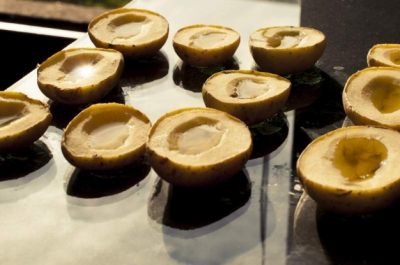Oil and potatoes
There are many types of potato, just like there are many kinds of oil. Is it not so? Here are some suggestions for pairing potatoes and oil. And a piece of advice for whoever believes that all potatoes – and oils, for that matter – are the same. The truth is otherwise. Some varieties have a tender texture, others instead can be firm, waxy or floury. And there are also the so-called new potatoes

There is no such thing as a standard potato, but instead, there are all sorts of varieties, just like there are all kinds of olive oil. Only knowledge and experience can fully elevate and enhance the features of these two ingredients.
Tender-fleshed potatoes
These varieties blend perfectly with the flavours of the other ingredients; they more or less keep their shape upon cooking and pair excellently with delicately fruity oil, with a slight hint of bitterness and pungency but soft and velvety on the palate.
Tender-fleshed potatoes are ideal for oven-baked (roasted potatoes, potatoes au gratin, crisp potato, onion and rosemary cake) and fried dishes (sauté potatoes with speck or parsley).
Waxy potatoes
These varieties have a thin, red skin and yellow flesh; they stay firm throughout the cooking process and pair excellently with averagely or even intensely fruity extra virgin oils with a strong pungency and bitterness.
They are ideal for steaming (potatoes en papillote with anchovy and broccoli sauce; octopus with potatoes, baby tomatoes and capers) or tossed in a salad (artichoke salad with potatoes and valerian; autumn salad with grapes, carrots, potatoes and feta cheese; potato salad with chives).
Firm-textured potatoes
These potatoes have a firm yellow flesh and are usually employed for manufacturing crisps at an industrial level. For economic reasons, olive oil is rarely used in this process.
At a non-professional level, these varieties are perfect for roasts, and pair with fruity oils of average intensity.
Floury potatoes
These are white-fleshed varieties that tend to lose their shape upon cooking and usually absorb very little oil. They pair well with well-balanced, delicately fruity oils, having only a hint of bitterness and pungency.
Floury varieties are ideal for creamed soups (potage parmentier with rosemary, taleggio cheese and wild mushrooms) and gnocchi, but are also excellent when mashed (mashed potato and celeriac with mustard and parmesan) and sautéed. At both domestic and professional levels they are the potato of choice for fried dishes such as chips, potato croquettes with herbs and almonds, potato and pumpkin fritters with ginger and wild herbs, mini potato tortillas with onions and fresh tomatoes.
New potatoes
To some extent, these potatoes can be grouped into a different class; they are characterized by their small size and thin, wispy skin, a result of their being harvested before reaching maturity. They are excellent with mildly fruity extra virgin oils, neither overly bitter nor pungent.
New potatoes are usually cooked unpeeled (roasted new potatoes with rosemary, new potato cake, spit-roasted new potatoes).
The top photo (credits: Plum / Olio Officina) shows a detail of “Patatolio” (“Potatoil”), a work by Carmine Caputo di Roccanova, on display at the 2014 Olio Officina Festival. Trivia: members of the public unwittingly ate the creation of the artist.
To comment you have to register
If you're already registered you can click here to access your account
or click here to create a new account


Comment this news